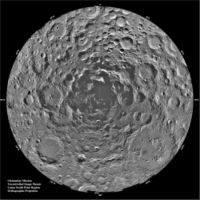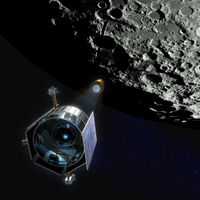Shackleton (crater)
2008/9 Schools Wikipedia Selection. Related subjects: Space (Astronomy)
| Crater characteristics | |
 South lunar pole as imaged by Clementine. Shackleton is in the small, dark patch at centre. NASA photo. |
|
| Coordinates | 89.9° S, 0.0° E |
|---|---|
| Diameter | 19 km |
| Depth | 2 km |
| Colongitude | 0° at sunrise |
| Eponym | Ernest Shackleton |
The Shackleton crater, named after Ernest Shackleton, a noted explorer of Antarctic, lies at the south pole of the Moon. The peaks along the crater rim are exposed to almost continual sunlight, while the interior is perpetually in shadow. The low-temperature interior of this crater functions as a cold trap that may capture and freeze volatiles shed during comet impacts on the Moon. Measurements by the Lunar Prospector spacecraft showed higher than normal amounts of hydrogen within the crater, which may indicate the presence of water ice.
Description
The rotational axis of the Moon lies within the rim of the Shackleton crater, and is only a few kilometers from its centre. The crater is small (about 19 km in diameter), and from Earth is viewed edge-on in a region of rough, cratered terrain. The rim is slightly raised about the surrounding surface and it has an outer rampart that has been only lightly impacted. No significant craters intersect the rim, which may indicate a relatively young feature.
Because the orbit of the Moon is only tilted 1.5° from the ecliptic, the interior of this crater lies in perpetual darkness. Peaks along the rim of the crater are almost continually illuminated by sunlight, spending about 80-90% of each lunar orbit exposed to the Sun. Continuously illuminated mountains have been termed peaks of eternal light and have been predicted to exist since the 1900s.
Nearby craters of note include the Shoemaker, Sverdrup, De Gerlache, and Faustini craters. Somewhat further away, on the eastern hemisphere of the lunar near side, are the larger Amundsen and Scott craters, named for two other early explorers of the Antarctic continent.
Exploration
From the perspective of the Earth, this crater lies along the southern limb of the Moon, making observation difficult. Detailed mapping of the polar regions and farside of the Moon did not occur until the advent of orbiting spacecraft. The Shackleton crater lies entirely within the rim of the immense South Pole-Aitken basin, which is the largest known impact formation in the Solar system. This basin is over 12 kilometers deep, and an exploration of its properties could provide useful information about the lunar interior.
A neutron spectrometer on board the Lunar Prospector spacecraft detected enhanced concentrations of hydrogen close to the northern and southern lunar poles, including the crater Shackleton. At the end of this mission in July 1999, the spacecraft was crashed into the nearby Shoemaker crater in the hope of detecting from Earth-based telescopes an impact-generated plume containing water vapor. The impact event did not produce any detectable water vapor, and this may be an indication that the hydrogen is not in the form of hydrated minerals, or that the impact site did not contain any ice. Alternatively, it is possible that the crash did not excavate deeply enough into the regolith to liberate significant quantities of water vapor.
From images of the crater edge taken from orbit, Shackleton appears to be a relatively young crater. A young crater would indicate that the inner sides are relatively steep, which may make traversing the sides relatively difficult for a robotic vehicle. In addition, it is possible that the interior floor might not have collected a significant quantity of volatiles since its formation. However other craters in the vicinity are considerably older, and may contain significant deposits of hydrogen, possibly in the form of water ice. (See Shoemaker crater, for example.)
Radar studies following the Lunar Prospector mission demonstrate that the inner walls of Shackleton are similar in reflective characteristics to those of some sunlit craters. In particular, the surroundings appear to contain a significant number of blocks in its ejecta blanket, suggesting that its radar properties are a result of surface roughness, and not ice deposits, as was previously suggested from a radar experiment involving the Clementine mission. This interpretation, however, is not universally agreed upon within the scientific community.
In 2006, NASA announced that a secondary payload would accompany the Lunar Reconnaissance Orbiter. This device, known as the Lunar Crater Observation and Sensing Satellite ( LCROSS) will observe the impact of the EDUS (Earth Departure Upper Stage) within a crater at a lunar pole. Shackleton crater has been suggested as a potential target for this mission, but the final target has not yet been selected. After flying through the plume of debris, the LCROSS will subsequently impact in the same crater. The impacts will be monitored from Earth and satellites, with the goal of detecting water ice in the crater. The EDUS will impact at about 2.5 km/s., and is expected to create an impact crater about 100 m in diameter and 5 m deep. The resulting debris should reach an altitude of approximately 50 km. The impact of the LCROSS should produce similar results.
Potential uses
Because of the almost constant illumination of the crater rim, it is considered as a possible location for a future lunar outpost, with sunlight at this locale being converted into electricity using solar panels. The temperature at this site is also more favorable than at more equatorial latitudes as it does not experience the daily temperature extremes of 100 ° C when the Sun is overhead, to as low as −150 °C during the lunar night.
The continuous shadows in the south polar craters cause the floors of these formations to maintain a temperature that never exceeds about −173 °C, or 100 K. Any water vapor that arrives here following a cometary impact on the Moon would lie permanently frozen on or below the surface. This suggests that the crater floors could potentially be "mined" for deposits of hydrogen in water form, a commodity that is expensive to deliver directly from the Earth.
While scientific experiments performed by the Clementine and the Lunar Prospector could indicate the presence of water in the polar craters, the current evidence is far from definitive. There are doubts among scientists as to whether or not the hydrogen is in the form of ice, as well as to the concentration of this "ore" with depth below the surface. Resolution of this issue will require future missions to the Moon.
This crater has also been proposed as a future site for a large infrared telescope. The low temperature of the crater floor make it ideal for infrared observations, and solar cells placed along the rim could provide near-continuous power to the observatory. About 120 kilometers from the crater lies the 5-km-tall Malapert Mountain, a peak that is perpetually visible from the Earth, and which could serve as a radio relay station when suitably equipped.
The rim of Shackleton crater has been named by NASA as a potential candidate for the first manned moon base, slated to be up and running by 2020 with permanent occupants there by 2024. The location would promote self-sustainability for lunar residents, as perpetual sunlight on the south pole would provide energy for solar panels. Furthermore, the shadowed polar regions are believed to contain the frozen water necessary for human consumption and could also be harvested for fuel manufacture.
